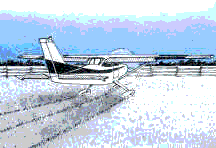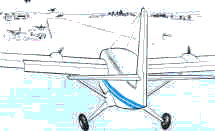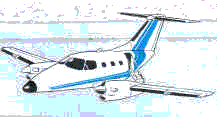Spring Runways
Springtime runways on grass and gravel can be uncertain at the best of times. Ground thaws and April rains can deteriorate these runways without notice. Before departing for a place you haven't visited since last year, call ahead; likewise, do a physical check of the full runway length before takeoff. These precautions might prevent you from turning turtle or making an unplanned diversion into the toolies.
The departure runway was 1800 ft. long. The surface was grass and moss on a sand/soil base. It was May 1994. Our Cessna 182 pilot had used this runway many times and, prior to this departure, had walked the beginning portion of the runway to check conditions. The engine run-up was normal, and our pilot used the recommended 20° flap short field takeoff procedure.

Halfway down the runway, the pilot felt resistance to the takeoff roll and noted that the aircraft was not accelerating. He rejected the takeoff and taxied back to try again. From a rolling start, the aircraft accelerated more quickly, but the pilot still felt resistance. A few hundred feet from the end, he tried to rotate but, fearing that the aircraft would stall, he rejected the takeoff again. This time, however, there was not enough room for a safe stop. The aircraft ran off the end and through a cedar rail fence, finally ending up in a ditch, substantially damaged. Our pilot and his passenger escaped with minor injuries.
On firm and dry grass, under the ambient conditions, and at the same weight, the takeoff roll should have been about 800 ft. However, had our pilot inspected the full length of the runway, he would have discovered that the second half was softer than the first and made a different takeoff decision, particularly after the first aborted attempt.
Originally Published: ASL 2/1997
Original Article: Spring Runways
Dangerous Practices Becoming Common at Uncontrolled Aerodromes

Few small aerodromes benefit from the luxury of parallel taxiways or holding bays near the runway threshold. They are one runway operations. Arriving and departing aircraft have to sequence themselves properly to avoid conflict. It can be particularly annoying when the parking area is at the far end, and a long taxi is involved before a pilot can get into position to safely do a run up and depart. Some pilots have to wait to taxi, or others have to wait to land.
As a result, in the interest of expediting traffic, pilots are developing dangerous habits. Habits that are not only being accepted but also, on occasion, being taught by instructors.
Pilots create their own parallel taxiways, in the grass, just off the runway. These are being used while other aircraft are arriving and departing. Aerodrome standards require that parallel taxiways be far enough from the runway to guarantee wingtip clearance plus a big safety margin. This means several hundred feet away, not just off the runway surface on the nicely graded and prepared area.
Many small strips have incorporated a turn around bay at the runway threshold. It's there so that pilots don't have to stand on the brake and power their way around the 180° turn to line up for takeoff. It is not a run up or holding bay. Holding/run up bays have similar requirements to parallel taxiways when it comes to distance back from the centreline, and the bays must be clearly marked.
By mutual arrangement, some pilots are landing over top of other aircraft occupying the runway, some are backtracking, and others are waiting for takeoff on the threshold.
Last, but not least, parallel takeoff/landing operations occur, with some pilots using the runway while others use the adjacent grass. The runway users conform to the recommended left hand circuit pattern; the grass users do both left and right hand circuits.
These are very dangerous practices. Picture a sunny weekend when everybody wants to fly. Picture a couple of arriving and departing transient pilots who don't know the local habits. Picture a collision.
Sometimes you just have to wait your turn.
Originally Published: ASL 2/1997
Original Article: Dangerous Practices Becoming Common at Uncontrolled Aerodromes
Cool as Ice

The Embraer EMB 121 was in cruise flight at 7000 ft. near Araxá, Brazil, when the captain noticed a pressurization problem with the aircraft's door. He went back to check. As he was checking the door, it blew open, and a steel door anchor cable severed his left hand.
"Luckily, I managed to grab hold of a handle with my right hand. When the co pilot noticed that half my body was outside the plane, he made a sharp 45° turn to the right and I was hurled back inside."
The captain returned to the cockpit "to calm the co pilot down and help him land the plane safely." He convinced one of the passengers to put the hand on ice. Doctors subsequently reattached it.
Our cool captain is not alone in making an unscheduled exit. Several years ago, a King Air pilot was outside his aircraft when the co pilot landed. He was hanging on to the door anchor chain.
In Issue 1/94, the Aviation Safety Letter featured a story of a 1985 accident in which a PA 31 crashed 10 min after taking off. Analysis of the wreckage showed that the autopilot was engaged, the pilot's seat belt was undone, and both halves of the clamshell cabin doors were open prior to impact. The pilot was not on board. Damage indicated that the upper half had come open in flight. To secure the upper half, you must first open the lower half and then close it again after securing the upper half. It was suspected that the pilot had engaged the autopilot and then attempted to close the doors in flight, but was flung out of the aircraft when he opened the lower half of the door. He was never found.
The lesson is clear: unless you are wearing a parachute and planning to jump, stay away from open doors in flight. Fix the problem on the ground.
Originally Published: ASL 2/1997
Original Article: Cool as Ice
Landed OK... But Couldn't Call for Help!
Recently, a Cessna pilot in the Yukon Territory did a great job of landing his aircraft in a swamp after the engine oil vacated the premises. Neither the pilot nor the aircraft was damaged during the few moments of stark terror that punctuated his many hours of routine flying.
Just before the landing, the pilot transmitted a "Mayday" that was overheard by two overflying aircrafts and relayed to a nearby FSS. However, the position transmitted was more generic than it was exact. The FSS notified the rescue coordination centre (RCC). A major search began promptly, employing about six aircrafts. The searchers found nothing the first day.
The next morning, an RCMP aircraft aiding in the search found the undamaged aircraft sitting forlornly in its swamp. A search and rescue (SAR) aircraft sped to the scene and lifted out the uninjured pilot. So what's the problem?
A couple of things might have sped the rescue and reduce search costs. According to a report filed by the RCC after the event, "The pilot was unaware of effort put into search. Also had no clue that ELT could be picked up by satellite, his radios could be heard by overflights, or that numerous grizzly bears were in the area."
The pilot was not unique in not knowing how to attract SAR's attention to an emergency site. Other survivors have also awaited ... and awaited... and awaited rescue while neglecting to flash up the ELTs or radios to summon help quickly.
Rather than concentrate on the things that could have been done better, let's focus first on what went right. The "Mayday" call alerted two aircraft, the FSS and the RCC. The position was a bit vague but, in northern Canada, that's to be expected. Then there was the landing, which was apparently a superb piece of airmanship.
Could more have been done? As it turned out, yes. The aircraft contained an automatic fixed ELT and a portable ELT. The arrival did not excite the fixed ELT, and the pilot didn't think to turn on the portable. Thus, search aircraft had nothing to home to. After the landing, the pilot did not attempt to use the aircraft radios to contact high flyers. Oddly enough, not using the radios may have been the prudent course of action. A forced landing may have resulted in an unnoticed fuel leak. Flashing up the aircraft electrics could have resulted in a spark-a spark sufficient to ignite the spilled fuel. Although the resulting fireball and smoke plume might have attracted search aircraft, it's not a recommended technique.
Now let's sort out a few ground rules to help SAR pluck you from the site of your emergency landing. If, someday, you find yourself in the same situation as this pilot, down and undamaged but immobile-place the ELT function switch to the ON position. Leave it on. Within 90 min, COSPAS-SARSAT will hear it. Within three hours, SAR will have a fix. Someone will come to get you. As well, most military aircraft monitor 121.5 MHz, and if they or other high flyers in the area report your ELT, SAR might get there even sooner.
Are you using the aircraft radios to talk to local high flyers? If your forced landing was relatively jolt-free, there is no obvious damage, and you can't smell avgas, it's probably OK. But remember, avgas is distilled to be susceptible to small sparks. Turning on electrics may trigger a fireball that will alert SAR agencies three provinces away.
ELTs were intended to attract SAR to emergencies. A forced landing in a swamp with an oil free aircraft constitutes an emergency. In this case, the company had two ELTs aboard the aircraft. Either one could have been used to summon help to an aircraft and pilot that were going no farther that day. Fewer search aircraft would have been needed and the pilot would have spent less time contemplating nature. Fortunately, he did not have to contemplate the grizzly bears that are a formidable part of that area of nature.
And, contrary to popular opinion, grizzly bears don't have 121.5 MHz ears, so turning on the ELT won't attract them. It will attract the SAR aircraft that will prevent you from having to outrun them.
Originally Published: ASL 2/1997
Original Article: Landed OK...But Couldn't Call for Help!




























